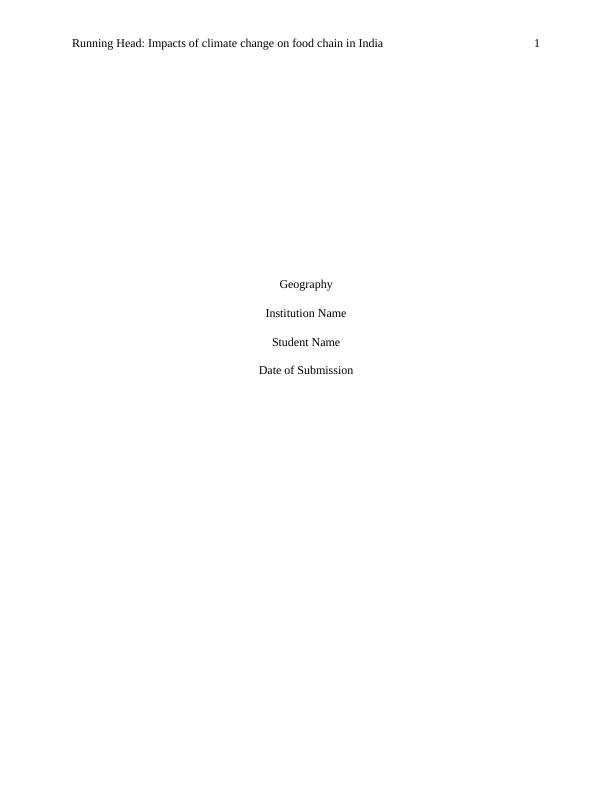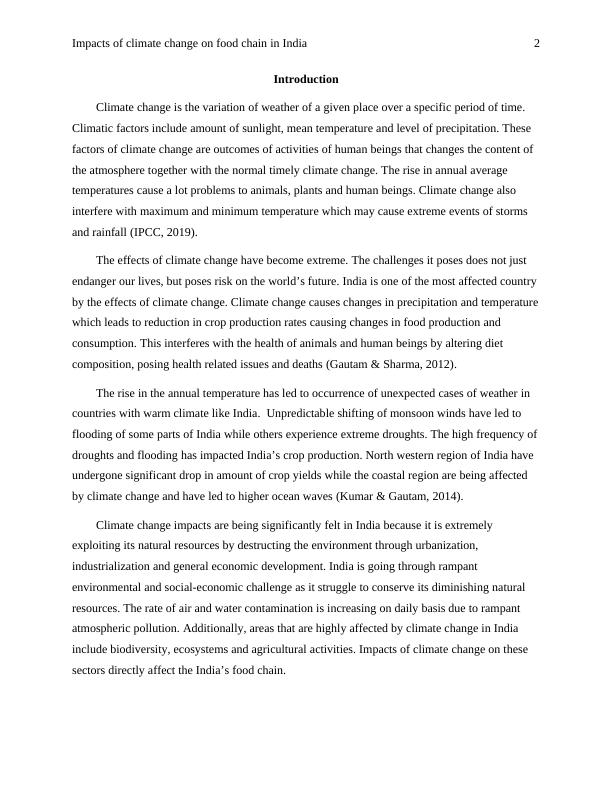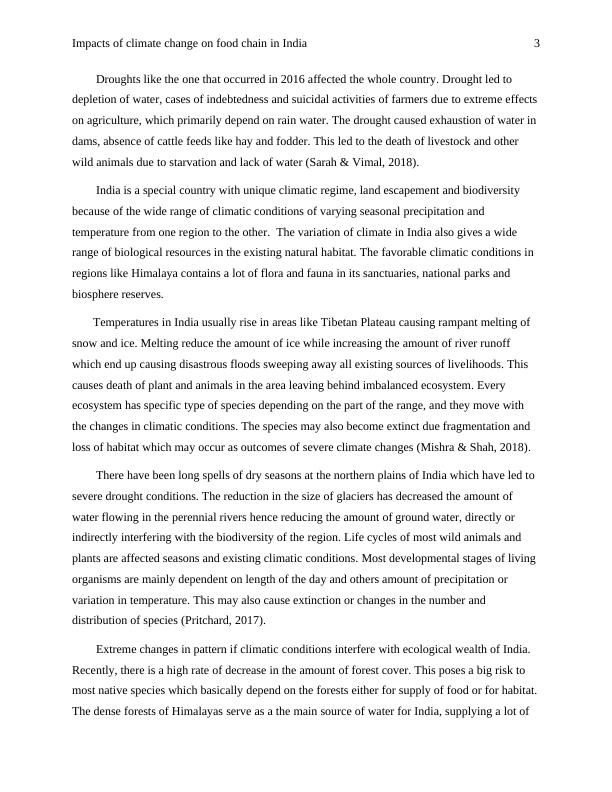Impacts of Climate Change on Food Chain in India
Added on 2023-03-23
10 Pages3596 Words23 Views
Running Head: Impacts of climate change on food chain in India 1
Geography
Institution Name
Student Name
Date of Submission
Geography
Institution Name
Student Name
Date of Submission

Impacts of climate change on food chain in India 2
Introduction
Climate change is the variation of weather of a given place over a specific period of time.
Climatic factors include amount of sunlight, mean temperature and level of precipitation. These
factors of climate change are outcomes of activities of human beings that changes the content of
the atmosphere together with the normal timely climate change. The rise in annual average
temperatures cause a lot problems to animals, plants and human beings. Climate change also
interfere with maximum and minimum temperature which may cause extreme events of storms
and rainfall (IPCC, 2019).
The effects of climate change have become extreme. The challenges it poses does not just
endanger our lives, but poses risk on the world’s future. India is one of the most affected country
by the effects of climate change. Climate change causes changes in precipitation and temperature
which leads to reduction in crop production rates causing changes in food production and
consumption. This interferes with the health of animals and human beings by altering diet
composition, posing health related issues and deaths (Gautam & Sharma, 2012).
The rise in the annual temperature has led to occurrence of unexpected cases of weather in
countries with warm climate like India. Unpredictable shifting of monsoon winds have led to
flooding of some parts of India while others experience extreme droughts. The high frequency of
droughts and flooding has impacted India’s crop production. North western region of India have
undergone significant drop in amount of crop yields while the coastal region are being affected
by climate change and have led to higher ocean waves (Kumar & Gautam, 2014).
Climate change impacts are being significantly felt in India because it is extremely
exploiting its natural resources by destructing the environment through urbanization,
industrialization and general economic development. India is going through rampant
environmental and social-economic challenge as it struggle to conserve its diminishing natural
resources. The rate of air and water contamination is increasing on daily basis due to rampant
atmospheric pollution. Additionally, areas that are highly affected by climate change in India
include biodiversity, ecosystems and agricultural activities. Impacts of climate change on these
sectors directly affect the India’s food chain.
Introduction
Climate change is the variation of weather of a given place over a specific period of time.
Climatic factors include amount of sunlight, mean temperature and level of precipitation. These
factors of climate change are outcomes of activities of human beings that changes the content of
the atmosphere together with the normal timely climate change. The rise in annual average
temperatures cause a lot problems to animals, plants and human beings. Climate change also
interfere with maximum and minimum temperature which may cause extreme events of storms
and rainfall (IPCC, 2019).
The effects of climate change have become extreme. The challenges it poses does not just
endanger our lives, but poses risk on the world’s future. India is one of the most affected country
by the effects of climate change. Climate change causes changes in precipitation and temperature
which leads to reduction in crop production rates causing changes in food production and
consumption. This interferes with the health of animals and human beings by altering diet
composition, posing health related issues and deaths (Gautam & Sharma, 2012).
The rise in the annual temperature has led to occurrence of unexpected cases of weather in
countries with warm climate like India. Unpredictable shifting of monsoon winds have led to
flooding of some parts of India while others experience extreme droughts. The high frequency of
droughts and flooding has impacted India’s crop production. North western region of India have
undergone significant drop in amount of crop yields while the coastal region are being affected
by climate change and have led to higher ocean waves (Kumar & Gautam, 2014).
Climate change impacts are being significantly felt in India because it is extremely
exploiting its natural resources by destructing the environment through urbanization,
industrialization and general economic development. India is going through rampant
environmental and social-economic challenge as it struggle to conserve its diminishing natural
resources. The rate of air and water contamination is increasing on daily basis due to rampant
atmospheric pollution. Additionally, areas that are highly affected by climate change in India
include biodiversity, ecosystems and agricultural activities. Impacts of climate change on these
sectors directly affect the India’s food chain.

Impacts of climate change on food chain in India 3
Droughts like the one that occurred in 2016 affected the whole country. Drought led to
depletion of water, cases of indebtedness and suicidal activities of farmers due to extreme effects
on agriculture, which primarily depend on rain water. The drought caused exhaustion of water in
dams, absence of cattle feeds like hay and fodder. This led to the death of livestock and other
wild animals due to starvation and lack of water (Sarah & Vimal, 2018).
India is a special country with unique climatic regime, land escapement and biodiversity
because of the wide range of climatic conditions of varying seasonal precipitation and
temperature from one region to the other. The variation of climate in India also gives a wide
range of biological resources in the existing natural habitat. The favorable climatic conditions in
regions like Himalaya contains a lot of flora and fauna in its sanctuaries, national parks and
biosphere reserves.
Temperatures in India usually rise in areas like Tibetan Plateau causing rampant melting of
snow and ice. Melting reduce the amount of ice while increasing the amount of river runoff
which end up causing disastrous floods sweeping away all existing sources of livelihoods. This
causes death of plant and animals in the area leaving behind imbalanced ecosystem. Every
ecosystem has specific type of species depending on the part of the range, and they move with
the changes in climatic conditions. The species may also become extinct due fragmentation and
loss of habitat which may occur as outcomes of severe climate changes (Mishra & Shah, 2018).
There have been long spells of dry seasons at the northern plains of India which have led to
severe drought conditions. The reduction in the size of glaciers has decreased the amount of
water flowing in the perennial rivers hence reducing the amount of ground water, directly or
indirectly interfering with the biodiversity of the region. Life cycles of most wild animals and
plants are affected seasons and existing climatic conditions. Most developmental stages of living
organisms are mainly dependent on length of the day and others amount of precipitation or
variation in temperature. This may also cause extinction or changes in the number and
distribution of species (Pritchard, 2017).
Extreme changes in pattern if climatic conditions interfere with ecological wealth of India.
Recently, there is a high rate of decrease in the amount of forest cover. This poses a big risk to
most native species which basically depend on the forests either for supply of food or for habitat.
The dense forests of Himalayas serve as a the main source of water for India, supplying a lot of
Droughts like the one that occurred in 2016 affected the whole country. Drought led to
depletion of water, cases of indebtedness and suicidal activities of farmers due to extreme effects
on agriculture, which primarily depend on rain water. The drought caused exhaustion of water in
dams, absence of cattle feeds like hay and fodder. This led to the death of livestock and other
wild animals due to starvation and lack of water (Sarah & Vimal, 2018).
India is a special country with unique climatic regime, land escapement and biodiversity
because of the wide range of climatic conditions of varying seasonal precipitation and
temperature from one region to the other. The variation of climate in India also gives a wide
range of biological resources in the existing natural habitat. The favorable climatic conditions in
regions like Himalaya contains a lot of flora and fauna in its sanctuaries, national parks and
biosphere reserves.
Temperatures in India usually rise in areas like Tibetan Plateau causing rampant melting of
snow and ice. Melting reduce the amount of ice while increasing the amount of river runoff
which end up causing disastrous floods sweeping away all existing sources of livelihoods. This
causes death of plant and animals in the area leaving behind imbalanced ecosystem. Every
ecosystem has specific type of species depending on the part of the range, and they move with
the changes in climatic conditions. The species may also become extinct due fragmentation and
loss of habitat which may occur as outcomes of severe climate changes (Mishra & Shah, 2018).
There have been long spells of dry seasons at the northern plains of India which have led to
severe drought conditions. The reduction in the size of glaciers has decreased the amount of
water flowing in the perennial rivers hence reducing the amount of ground water, directly or
indirectly interfering with the biodiversity of the region. Life cycles of most wild animals and
plants are affected seasons and existing climatic conditions. Most developmental stages of living
organisms are mainly dependent on length of the day and others amount of precipitation or
variation in temperature. This may also cause extinction or changes in the number and
distribution of species (Pritchard, 2017).
Extreme changes in pattern if climatic conditions interfere with ecological wealth of India.
Recently, there is a high rate of decrease in the amount of forest cover. This poses a big risk to
most native species which basically depend on the forests either for supply of food or for habitat.
The dense forests of Himalayas serve as a the main source of water for India, supplying a lot of

End of preview
Want to access all the pages? Upload your documents or become a member.
Related Documents
Climate Change and how it Affects Agriculturelg...
|7
|1464
|20
IMPACT OF CLIMATE CHANGElg...
|4
|797
|13
Climate Change and Food Insecurity in Nepal: A Case Studylg...
|13
|3373
|215
Principles and Current Topics in Agro-food Economics & Policylg...
|9
|2894
|46
How Will Changing Climate Patterns Affect Food Security in the Next Ten Years?lg...
|10
|2072
|480
(PDF) Water Conservation for Agriculturelg...
|5
|1140
|195
